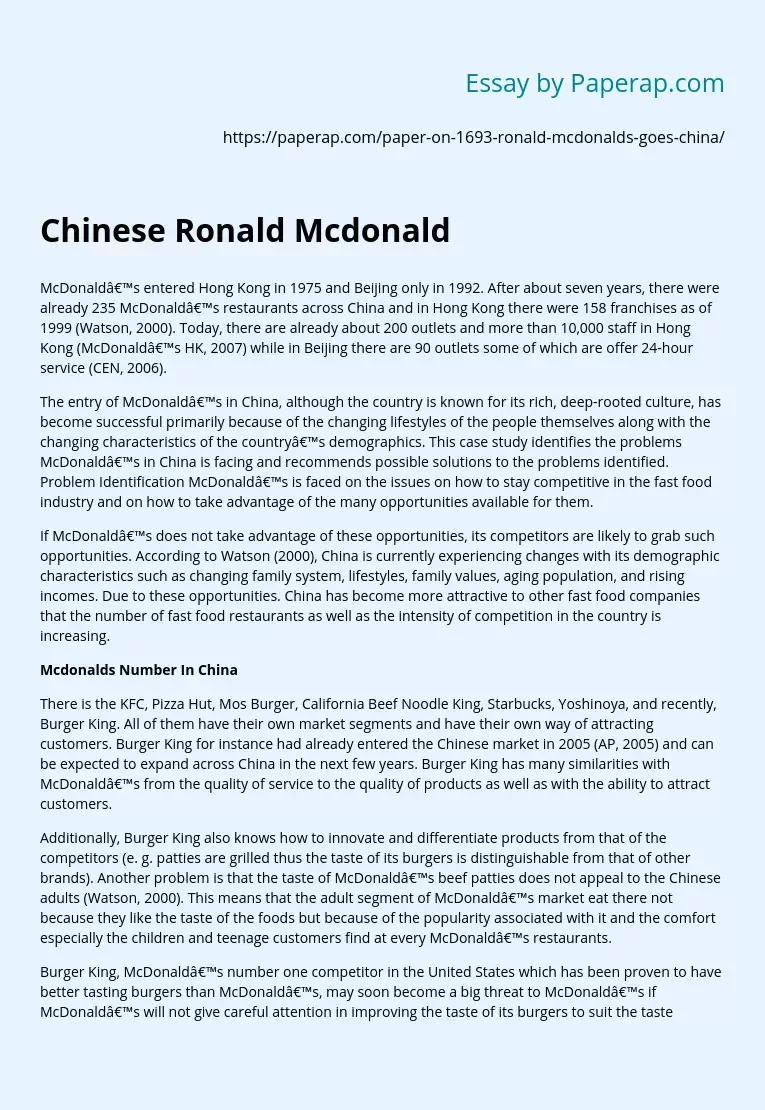Chinese Ronald Mcdonald
McDonald’s entered Hong Kong in 1975 and Beijing only in 1992. After about seven years, there were already 235 McDonald’s restaurants across China and in Hong Kong, there were 158 franchises as of 1999. Today, there are already about 200 outlets and more than 10,000 staff in Hong Kong (McDonald’s HK, 2007) while in Beijing there are 90 outlets some of which are offering 24-hour service.
The entry of McDonald’s in China, although the country is known for its rich, deep-rooted culture, has become successful primarily because of the changing lifestyles of the people themselves along with the changing characteristics of the country’s demographics.
This case study identifies the problems McDonald’s in China is facing and recommends possible solutions to the problems identified. Problem Identification McDonald’s is faced on the issues of how to stay competitive in the fast-food industry and on how to take advantage of the many opportunities available for them.
If McDonald’s does not take advantage of these opportunities, its competitors are likely to grab such opportunities.
According to Watson (2000), China is currently experiencing changes with its demographic characteristics such as changing family systems, lifestyles, family values, aging population, and rising incomes. Due to these opportunities. China has become more attractive to other fast-food companies that the number of fast-food restaurants, as well as the intensity of competition in the country, is increasing.
Mcdonalds Number In China
There is the KFC, Pizza Hut, Mos Burger, California Beef Noodle King, Starbucks, Yoshinoya, and recently, Burger King. All of them have their own market segments and have their own way of attracting customers.
Burger King for instance had already entered the Chinese market in 2005 (AP, 2005) and can be expected to expand across China in the next few years. Burger King has many similarities with McDonald’s from the quality of service to the quality of products as well as with the ability to attract customers.
Additionally, Burger King also knows how to innovate and differentiate products from that of the competitors. Another problem is that the taste of McDonald’s beef patties does not appeal to Chinese adults (Watson, 2000). This means that the adult segment of McDonald’s market eat there not because they like the taste of the foods but because of the popularity associated with it and the comfort especially the children and teenage customers find at every McDonald’s restaurant.
Burger King, McDonald’s number one competitor in the United States which has been proven to have better-tasting burgers than McDonald’s, may soon become a big threat to McDonald’s if McDonald’s will not give careful attention in improving the taste of its burgers to suit the taste preferences of the Chinese. Identification of Options or Alternatives McDonald’s may implement one or a combination of the following alternatives:
Intensify its communication and marketing efforts to ensure that McDonald’s remains attractive to the younger consumers, making up with the loss made due to the unattractiveness of McDonald’s burger to adults. McDonald’s definitely has a competitive advantage over its competitors due to its popularity and strong brand identity which was developed through its strong marketing and communication tools. This particular strength of McDonald’s can be further utilized in order to sustain its competitive advantage.
However, this alternative requires McDonald’s to allot an additional budget for its marketing strategies. Instead of allocating additional financial support for promotions and marketing, McDonald’s may opt to allocate budget for research and development in order for the company to innovate and improve the taste of its burger patties; that is, integrate Chinese taste preferences with the American burger. McDonald’s should conduct research to determine the specific taste of burgers that Chinese adults want and to alter the recipe of its traditional American burger patty.
In other words, although Chinese customers are now embracing American foods, it will be better if they can still get to eat the Chinese way even at McDonald’s. McDonald’s must focus on product innovation. According to Nonaka (1991, p. 25) innovation means “to recreate the world according to a particular vision or ideal”. If McDonald’s is really aiming to localize the company, it must then become serious in offering products with tastes that will be appreciated by the Chinese consumers.
McDonald’s is a food company thus, its focus must primarily be on the taste of its products and not only on providing customers the experience of eating in a friendly restaurant. McDonald’s may expand its operation by opening new outlets to be able to broaden its market reach and ensure that McDonald’s has a presence in all possible strategic locations. This alternative addresses the opportunities available for McDonald’s; however, it does not really solve the second problem identified above.
Chinese Ronald Mcdonald. (2019, Dec 05). Retrieved from https://paperap.com/paper-on-1693-ronald-mcdonalds-goes-china/

